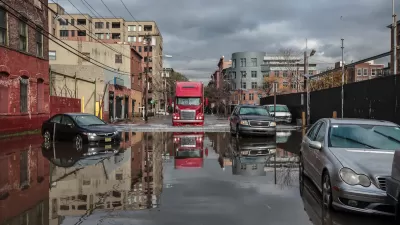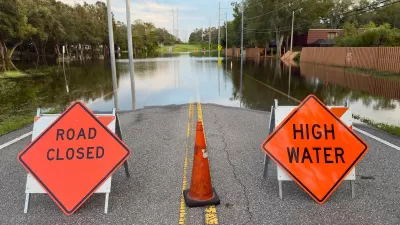Greg Hanscom reports on efforts by FEMA and the Green Building Council to incorporate "climate resiliency" into green building certification criteria in recognition of the increasing effects of climate change.
With the impacts of increasingly frequent severe storms already being felt across the country, and in the growing emergency response costs to government at all levels, FEMA recently joined the U.S. Green Building Council and researchers from the University of Michigan to roll out a new report [PDF] called Green Building and Climate Resilience.
With the report, which "went region-by-region to identify the risks associated with a changing climate" and the need to build for "climate resiliency," the Green Building Council, "an organization that has until now focused almost entirely on reducing our contributions to climate change, has turned its attention to the inevitable impacts of those contributions we've already made," writes Hanscom.
While some existing green strategies may help to mitigate the impacts of such threats as extreme heat events, more frequent droughts, higher-intensity hurricanes and storm surges, declining air quality, insect infestations, and more severe wildfire seasons, there is much more that can be done to prepare the built environment in our most vulnerable communities.
According to Hanscom, "It's early yet, but there may be a day when, if you want to get your house LEED certified, you'll need to prove not just that it is eco-friendly today, but that it can survive Mother Nature's worst in order to be so a few decades from now."
FULL STORY: Gimme bomb shelter: FEMA pushes for disaster-proof green buildings

Alabama: Trump Terminates Settlements for Black Communities Harmed By Raw Sewage
Trump deemed the landmark civil rights agreement “illegal DEI and environmental justice policy.”

Study: Maui’s Plan to Convert Vacation Rentals to Long-Term Housing Could Cause Nearly $1 Billion Economic Loss
The plan would reduce visitor accommodation by 25% resulting in 1,900 jobs lost.

Why Should We Subsidize Public Transportation?
Many public transit agencies face financial stress due to rising costs, declining fare revenue, and declining subsidies. Transit advocates must provide a strong business case for increasing public transit funding.

Paris Bike Boom Leads to Steep Drop in Air Pollution
The French city’s air quality has improved dramatically in the past 20 years, coinciding with a growth in cycling.

Why Housing Costs More to Build in California Than in Texas
Hard costs like labor and materials combined with ‘soft’ costs such as permitting make building in the San Francisco Bay Area almost three times as costly as in Texas cities.

San Diego County Sees a Rise in Urban Coyotes
San Diego County experiences a rise in urban coyotes, as sightings become prevalent throughout its urban neighbourhoods and surrounding areas.
Urban Design for Planners 1: Software Tools
This six-course series explores essential urban design concepts using open source software and equips planners with the tools they need to participate fully in the urban design process.
Planning for Universal Design
Learn the tools for implementing Universal Design in planning regulations.
Smith Gee Studio
Alamo Area Metropolitan Planning Organization
City of Santa Clarita
Institute for Housing and Urban Development Studies (IHS)
City of Grandview
Harvard GSD Executive Education
Toledo-Lucas County Plan Commissions
Salt Lake City
NYU Wagner Graduate School of Public Service





























